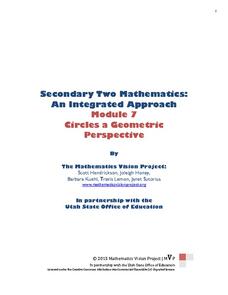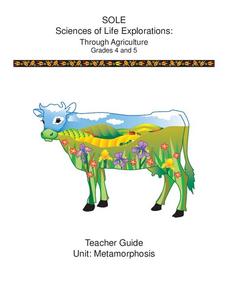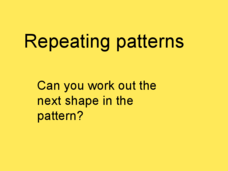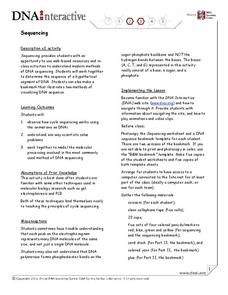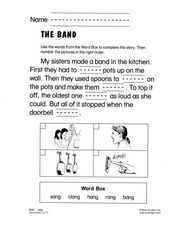Virginia Department of Education
Surface Area and Volume
Partners use materials to wrap three-dimensional objects to determine the formula for surface area. The groups use an orange to calculate the amount of peel it takes to completely cover the fruit. Using manipulatives, individuals then...
Mathematics Vision Project
Circles: A Geometric Perspective
Circles are the foundation of many geometric concepts and extensions - a point that is thoroughly driven home in this extensive unit. Fundamental properties of circles are investigated (including sector area, angle measure, and...
Curated OER
Practice Book O
Whether you need resources for reading comprehension, literary analysis, phonics, vocabulary, or text features, an extensive packet of worksheets is sure to fit your needs. Based on a fifth-grade curriculum but applicable to any level of...
Cornell University
Metamorphosis
Looking for an insect unit that addresses multiple skill strategies? Young entomologists explore multiple life cycles of insects that go through metamorphosis. The brainteasers and mobile activity spark learner interest before guiding...
Education City
Black History Month
Enhance Black History Month with a twenty-page resource designed to boost scholars' knowledge of the great accomplishments made by African Americans. Learners take in fun facts about famous inventors such as George Washington Carver and...
Curated OER
Chicka Chicka Boom Boom
Young readers write alphabet letters. They review the alphabet and examine the relationship between letters and sounds. A final activity has each child sequence the story together.
Curated OER
Introducing Essential Questions
If you are introducing procedures to your class, then this sequence of instructions will be useful. Learners are given a specific set of directions, and are allotted a specific amount of time in which to finish them. The instructions on...
Tell City Schools
The Cay
Support your instruction of The Cay by Theodore Taylor with this extensive unit of materials. Provided here are prereading activities, worksheets and discussion questions for the entire book, and reading quizzes that you can use to check...
Howard Hughes Medical Institute
Biodiversity and Evolutionary Trees
Compare what shells look like on the outside with what makes that happen on the inside. Scholars begin by sorting an various seashells by their physical characteristics into phylogenetic trees. They then conduct a DNA comparison of...
Curated OER
Comparing and Ordering Fractions, Mixed Numbers, and Decimals
Create your own fraction kits by folding and labeling paper using fraction vocabulary. Learners then work in groups to use these in comparing and sequencing both whole numbers and fractions. They also create unit cubes and develop an...
Curated OER
The Personal Narrative - Part Five
Create a class anthology with your young writers. In this personal narrative lesson, each writer reflects on actions and events from their own lives and chronicles them in a three-part written sequence. They create a table of contents...
Curated OER
Repeating Patterns
Pattern recognition is a very important skill to foster in younger children. It helps boost algebraic reasoning, logical reasoning, and mathematical reasoning skills. Here are 11 different shape patterns for learners to complete. They...
Curated OER
Following Instructions
Get scholars thinking about the scientific process with this fun experiment they can do at home. Learners practice reading directions as they underline each instruction in a procedural paragraph. They create a flow chart and record what...
Curated OER
Reading Practice: Winnie-the-Pooh
Whether your first graders can read or not, they will enjoy this comprehension activity. They read or listen to an excerpt from a Winnie-the-Pooh story, they predict what will happen next, then draw Pooh Bear's favorite food. A compare...
Curated OER
Writing a Letter
Here are three well-thought-out tasks intended to build good note taking and letter writing skills. The class reads three short letters, determines who wrote them (based on context) and takes notes as a pre-writing activity. They finish...
Curated OER
Sequencing
Students gather information about gene sequencing. In this biology lesson, students use the Internet to access information about gene sequencing, then work in pairs to read and record a gene sequence. Lesson includes extension activities.
Curated OER
Constructing a Phylogenetic Tree Using DNA Sequence Data
Students analyze DNA sequence differences between organisms in order to establish a reasonable picture of the evolutionary relationships between them. They take the role of molecular biologists and make genetic changes and constructing...
Curated OER
Sequencing the Cystic Fibrosis Gene: A Simulation
Ninth graders use this activity to simulate the sequencing of gene and to detect the presence of possible genetic defects. They use diagrams that represent bands of nucleotides in order to determine the sequence of a small piece of the...
Curated OER
Comparing mtDNA Sequences to Learn about Human Variation
This computer-based lesson will enable students to test their notions of "racial" similarity and difference by comparing mtDNA sequences as the students do in the first episode of RACE - The Power of an Illusion.
Curated OER
Sequencing Time
Students place events in sequence and assign relative times to each event. They gain an understanding of relative and numerical time and become familiar with the methods used by scientists to develop the Geologic Time Scale.
NASA
Solar Systems: Sequences and Probabilities
In this sequences and probability activity, students solve 3 problems by writing out all the possibilities for the solution and they use probability to find their answers. They determine the probability of solar flares happening on a...
Curated OER
The Band
In this identifying words spelled with "-ang" activity, students use the word bank to fill in the blanks with -ang words and then number the pictures in order. Students write 9 answers.
Math Salamanders Ltd.
Counting on by Digits Sheet 2
In this number sequence activity, learners fill in 40 missing numbers in sequence on 10 different number lines. Students calculate each single-digit step up for each one.
Curated OER
Games and Activities to Teach Molecular Genetics
Students demonstrate a working knowledge of cell interactions such as DNA replication, protein synthesis (transcription and translation), through active participation in a cooperative group.
Other popular searches
- Story Sequencing Activities
- Free Sequencing Activities
- Pizza Sequencing Activities
- Math Sequencing Activities
- Sequencing Activities 3rd
- Sequencing Activities Apples
- Money Sequencing Activities
- English Sequencing Activities
- Recipe Sequencing Activities
- Reading Sequencing Activities



